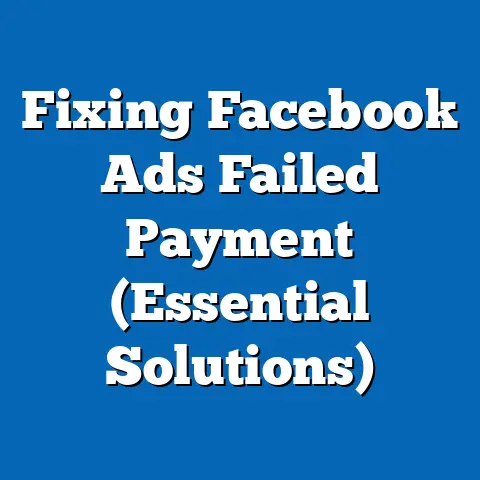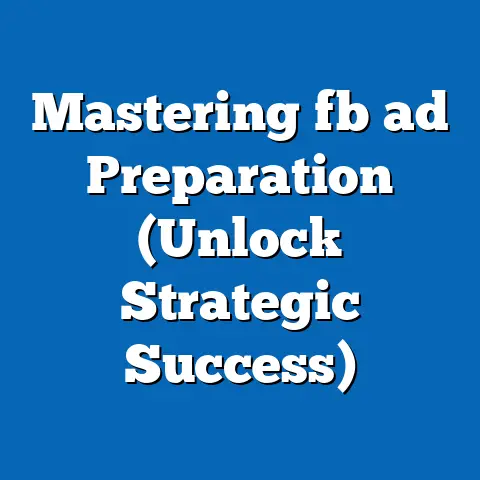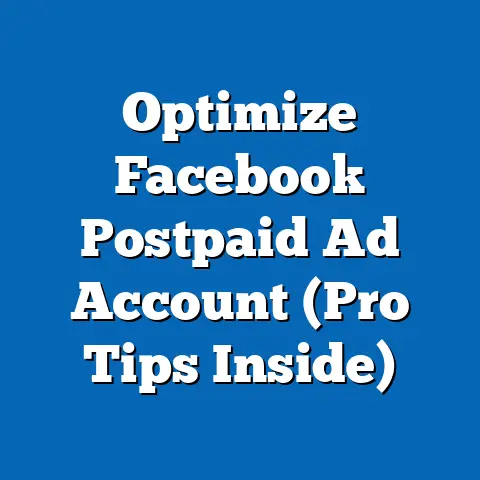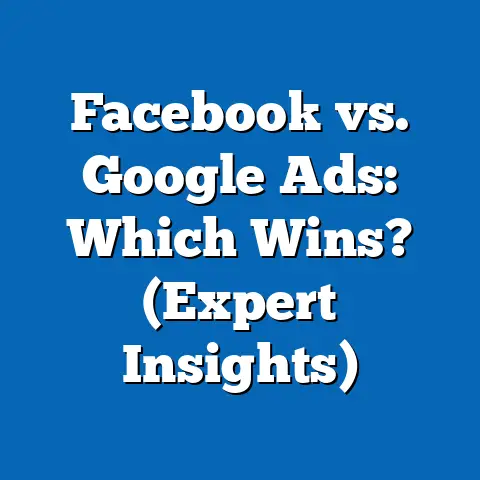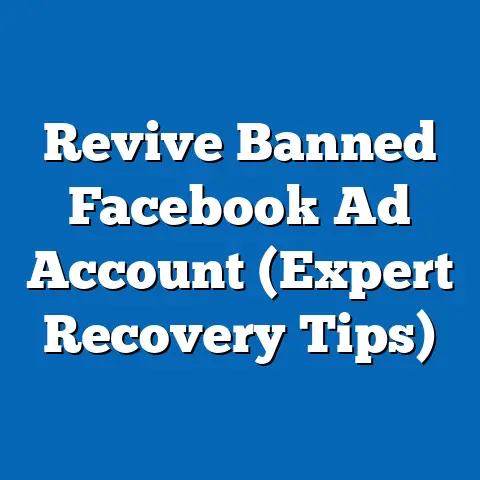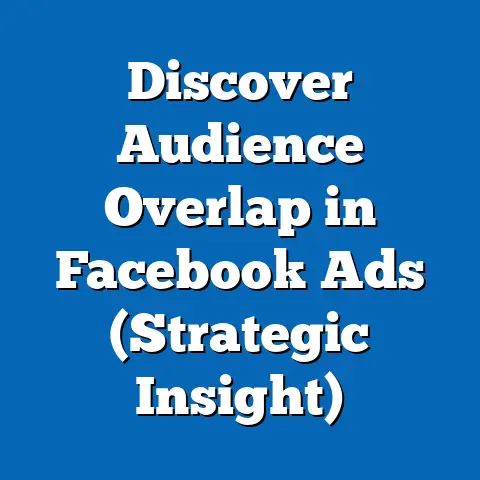Master Facebook Ads Buying Types (Proven Strategies)
Are you pouring money into Facebook Ads, only to be met with underwhelming results? I understand the frustration. I’ve seen countless businesses struggle to truly maximize their ad spend. The problem often isn’t the budget itself, but a lack of understanding of the different buying options Facebook offers. It’s like having a powerful engine but not knowing how to shift gears. You might get somewhere, but you’re definitely not reaching your full potential.
I’ve been there myself. Early in my career, I ran a campaign for a local bookstore, and while we saw some traffic, the ROI was disappointing. It wasn’t until I dug deeper into the intricacies of Facebook’s ad buying options that I started to see significant improvements.
The key is to understand that Facebook isn’t a one-size-fits-all platform. Mastering the different Facebook ads buying types is crucial for tailoring campaigns that deliver optimal results. It’s about choosing the right tool for the job, and that’s what I’m going to guide you through today.
In this article, I’ll break down the two primary Facebook ads buying types – Auction and Reach & Frequency – and equip you with proven strategies to make the most of each. I’ll share real-world examples, actionable tips, and insights that I’ve gained over years of managing successful Facebook ad campaigns. By the end of this guide, you’ll have the knowledge and confidence to elevate your ad campaigns and achieve your marketing goals. Let’s dive in!
Understanding Facebook Ads Buying Types
Before we jump into specific strategies, let’s lay the foundation by understanding the two main ways you can buy ads on Facebook: Auction and Reach & Frequency. Choosing the right buying type is the first, and arguably most important, step in creating a successful campaign.
Auction Buying: The Dynamic Bidding Landscape
The Auction buying type is the default for most Facebook advertisers, and for good reason. It’s a dynamic and flexible system that allows you to bid for ad placements based on your target audience, budget, and campaign goals. Think of it as a real-time marketplace where advertisers compete for the attention of Facebook users.
Here’s how it works:
- You define your target audience: You specify who you want to reach based on demographics, interests, behaviors, and more.
- You set your budget and bidding strategy: You decide how much you’re willing to spend and how aggressively you want to bid for ad placements.
- Facebook’s algorithm determines the winners: Based on your bid, ad quality, and relevance to the user, Facebook’s algorithm decides which ads to show and in what order.
The Auction model is ideal for campaigns where you want to optimize for specific outcomes, such as conversions, leads, or app installs. It’s also a good choice if you’re willing to actively manage your campaigns and adjust your bids based on performance.
Why is it important? The Auction allows for precise targeting and optimization. You can constantly refine your campaigns based on real-time data, ensuring that you’re getting the most bang for your buck.
How to interpret it? A high cost-per-result in the Auction setting usually means your audience is either too broad or the ad creative is not resonating with your target demographics.
How it relates to other metrics? The Auction buying type is heavily influenced by factors like your Quality Ranking (relevance of your ad to the target audience) and Engagement Rate.
Reach & Frequency Buying: Predictable and Consistent
The Reach & Frequency buying type offers a more predictable and controlled approach to advertising on Facebook. Instead of bidding for ad placements, you reserve a specific audience and frequency of ad delivery in advance. This model is perfect for brand awareness campaigns where you want to reach a large audience with a consistent message.
Here’s how it works:
- You define your target audience: Similar to the Auction model, you specify who you want to reach.
- You set your budget and schedule: You decide how much you want to spend and how long you want your campaign to run.
- Facebook guarantees reach and frequency: Facebook guarantees that your ads will be shown to a certain percentage of your target audience a certain number of times within your specified timeframe.
Reach & Frequency buying is ideal for campaigns where you want to build brand awareness, launch a new product, or reinforce your brand message. It’s also a good choice if you want to ensure that your ads are seen by a specific audience a certain number of times.
Why is it important? Reach & Frequency offers predictability and control over ad delivery. You know exactly how many people you’re going to reach and how often they’re going to see your ads.
How to interpret it? A low frequency rate for Reach & Frequency buying can undermine the whole purpose of the campaign.
How it relates to other metrics? Reach & Frequency buying is closely tied to metrics like Brand Recall and Ad Recognition.
Key Differences Summarized
| Feature | Auction Buying | Reach & Frequency Buying |
|---|---|---|
| Bidding | Competitive bidding for ad placements | Reserved audience and frequency |
| Control | Less control over ad delivery, more optimization | More control over ad delivery, less optimization |
| Ideal For | Performance-driven campaigns (conversions, leads) | Brand awareness campaigns |
| Flexibility | Highly flexible, can be adjusted in real-time | Less flexible, requires upfront planning |
| Predictability | Less predictable, results can fluctuate | More predictable, guaranteed reach and frequency |
| Feature | Auction Buying | Reach & Frequency Buying |
|---|---|---|
| Bidding | Competitive bidding for ad placements | Reserved audience and frequency |
| Control | Less control over ad delivery, more optimization | More control over ad delivery, less optimization |
| Ideal For | Performance-driven campaigns (conversions, leads) | Brand awareness campaigns |
| Flexibility | Highly flexible, can be adjusted in real-time | Less flexible, requires upfront planning |
| Predictability | Less predictable, results can fluctuate | More predictable, guaranteed reach and frequency |
Takeaway: Understanding the core differences between Auction and Reach & Frequency buying is essential for aligning your ad campaigns with your business goals. Carefully consider your objectives, target audience, and budget before choosing the right buying type.
Next Steps: Now that you have a solid understanding of the two primary Facebook ads buying types, let’s dive into proven strategies for maximizing your results with each.
Proven Strategies for Auction Buying
The Auction buying type is a powerful tool, but it requires a strategic approach to truly unlock its potential. In this section, I’ll share proven strategies for optimizing your Auction campaigns, based on my experience and insights from successful advertisers.
Strategy 1: Bidding Techniques
Bidding is the heart of the Auction model. It’s how you tell Facebook how much you’re willing to pay to show your ads to your target audience. Choosing the right bidding strategy can make or break your campaign.
Here are some common bidding strategies and when to use them:
-
Lowest Cost (formerly Automatic Bidding): This is the default bidding strategy, and it’s a good starting point for most campaigns. Facebook’s algorithm will automatically bid to get you the most results for your budget. I’ve found this works well for campaigns where you’re not overly concerned about cost per result and just want to maximize volume.
- When to use: When you’re new to Facebook Ads, have a limited budget, or want to maximize volume without specific cost targets.
-
Bid Cap: This strategy allows you to set a maximum bid for each auction. This gives you more control over your costs, but it can also limit your reach if your bid is too low. I’ve used Bid Cap successfully when I have a specific cost per result in mind and want to stay within that limit.
-
When to use: When you have a specific cost per result target and want to control your costs tightly.
-
Target Cost: This strategy tells Facebook to aim for a specific cost per result. Facebook’s algorithm will adjust your bids to try to achieve your target cost. I’ve found this works well for campaigns where you have a good understanding of your target audience and conversion funnel.
-
When to use: When you have a good understanding of your target audience and conversion funnel, and want to achieve a specific cost per result.
-
Cost Cap: This strategy, similar to Target Cost, allows Facebook to bid within a range to achieve your desired results while maintaining efficiency.
-
When to use: When you have specific cost goals but need a bit more flexibility than the Bid Cap strategy.
Lowest Cost (formerly Automatic Bidding): This is the default bidding strategy, and it’s a good starting point for most campaigns. Facebook’s algorithm will automatically bid to get you the most results for your budget. I’ve found this works well for campaigns where you’re not overly concerned about cost per result and just want to maximize volume.
- When to use: When you’re new to Facebook Ads, have a limited budget, or want to maximize volume without specific cost targets.
-
Bid Cap: This strategy allows you to set a maximum bid for each auction. This gives you more control over your costs, but it can also limit your reach if your bid is too low. I’ve used Bid Cap successfully when I have a specific cost per result in mind and want to stay within that limit.
-
When to use: When you have a specific cost per result target and want to control your costs tightly.
-
Target Cost: This strategy tells Facebook to aim for a specific cost per result. Facebook’s algorithm will adjust your bids to try to achieve your target cost. I’ve found this works well for campaigns where you have a good understanding of your target audience and conversion funnel.
-
When to use: When you have a good understanding of your target audience and conversion funnel, and want to achieve a specific cost per result.
-
Cost Cap: This strategy, similar to Target Cost, allows Facebook to bid within a range to achieve your desired results while maintaining efficiency.
-
When to use: When you have specific cost goals but need a bit more flexibility than the Bid Cap strategy.
Bid Cap: This strategy allows you to set a maximum bid for each auction. This gives you more control over your costs, but it can also limit your reach if your bid is too low. I’ve used Bid Cap successfully when I have a specific cost per result in mind and want to stay within that limit.
When to use: When you have a specific cost per result target and want to control your costs tightly.
Target Cost: This strategy tells Facebook to aim for a specific cost per result. Facebook’s algorithm will adjust your bids to try to achieve your target cost. I’ve found this works well for campaigns where you have a good understanding of your target audience and conversion funnel.
When to use: When you have a good understanding of your target audience and conversion funnel, and want to achieve a specific cost per result.
Cost Cap: This strategy, similar to Target Cost, allows Facebook to bid within a range to achieve your desired results while maintaining efficiency.
When to use: When you have specific cost goals but need a bit more flexibility than the Bid Cap strategy.
Example: I once ran a campaign for an e-commerce store selling handmade jewelry. Initially, I used the Lowest Cost bidding strategy, but the cost per purchase was higher than I wanted. I switched to Bid Cap, setting a maximum bid based on my desired profit margin. This allowed me to control my costs and improve my ROI.
Tip: Don’t be afraid to experiment with different bidding strategies. Monitor your results closely and adjust your bids as needed. Facebook’s algorithm is constantly learning, so what works today might not work tomorrow.
Strategy 2: Audience Targeting
Targeting the right audience is crucial for maximizing the effectiveness of your Auction campaigns. The more relevant your ads are to your target audience, the higher your Quality Ranking will be, and the lower your costs will be.
Here are some advanced targeting options to consider:
-
Custom Audiences: These are audiences that you create based on your existing customer data, such as email lists, website visitors, or app users. I’ve found Custom Audiences to be incredibly powerful for retargeting and upselling.
- Example: Uploading your email list to create a Custom Audience of existing customers and showing them ads for new products or special offers.
-
Lookalike Audiences: These are audiences that Facebook creates based on your Custom Audiences. Facebook’s algorithm identifies users who share similar characteristics and behaviors with your existing customers. Lookalike Audiences are a great way to expand your reach and find new customers who are likely to be interested in your products or services.
-
Example: Creating a Lookalike Audience based on your Custom Audience of existing customers to reach new users who share similar interests and demographics.
-
Detailed Targeting: This option allows you to target users based on their demographics, interests, behaviors, and more. Detailed Targeting is a great way to narrow your audience and ensure that your ads are seen by the most relevant users.
-
Example: Targeting users who are interested in “yoga,” “meditation,” and “wellness” if you’re selling yoga mats or mindfulness apps.
Custom Audiences: These are audiences that you create based on your existing customer data, such as email lists, website visitors, or app users. I’ve found Custom Audiences to be incredibly powerful for retargeting and upselling.
- Example: Uploading your email list to create a Custom Audience of existing customers and showing them ads for new products or special offers.
-
Lookalike Audiences: These are audiences that Facebook creates based on your Custom Audiences. Facebook’s algorithm identifies users who share similar characteristics and behaviors with your existing customers. Lookalike Audiences are a great way to expand your reach and find new customers who are likely to be interested in your products or services.
-
Example: Creating a Lookalike Audience based on your Custom Audience of existing customers to reach new users who share similar interests and demographics.
-
Detailed Targeting: This option allows you to target users based on their demographics, interests, behaviors, and more. Detailed Targeting is a great way to narrow your audience and ensure that your ads are seen by the most relevant users.
-
Example: Targeting users who are interested in “yoga,” “meditation,” and “wellness” if you’re selling yoga mats or mindfulness apps.
Lookalike Audiences: These are audiences that Facebook creates based on your Custom Audiences. Facebook’s algorithm identifies users who share similar characteristics and behaviors with your existing customers. Lookalike Audiences are a great way to expand your reach and find new customers who are likely to be interested in your products or services.
Example: Creating a Lookalike Audience based on your Custom Audience of existing customers to reach new users who share similar interests and demographics.
Detailed Targeting: This option allows you to target users based on their demographics, interests, behaviors, and more. Detailed Targeting is a great way to narrow your audience and ensure that your ads are seen by the most relevant users.
Example: Targeting users who are interested in “yoga,” “meditation,” and “wellness” if you’re selling yoga mats or mindfulness apps.
Example: I ran a campaign for a local gym targeting users who were interested in “fitness,” “healthy eating,” and “weight loss.” However, the results were mediocre. I then narrowed my audience to users who were also interested in “CrossFit,” “HIIT,” and “strength training.” This significantly improved my ad relevance and conversion rate.
Tip: Don’t be afraid to get granular with your targeting. The more specific you are, the more likely you are to reach the right audience.
Strategy 3: Ad Creative Optimization
Even with the best bidding strategy and targeting, your campaign will fall flat if your ad creative isn’t compelling. Your ad creative is what captures the attention of your target audience and motivates them to take action.
Here are some tips for crafting compelling ad creative:
-
Use high-quality visuals: Your images and videos should be visually appealing and relevant to your target audience. Avoid using stock photos or generic images. I’ve found that using authentic photos and videos of real people and products tends to perform better.
- Example: For a clothing brand, using high-quality photos of models wearing their clothes in real-life settings, rather than studio shots.
-
Write compelling ad copy: Your ad copy should be clear, concise, and persuasive. Highlight the benefits of your product or service and include a strong call to action. I often use questions or statements that directly address the potential customer’s pain points.
-
Example: “Tired of struggling with meal planning? Our meal prep service delivers healthy, delicious meals right to your door.”
-
A/B test different ad creatives: A/B testing is the process of comparing two or more versions of your ad creative to see which one performs better. Test different headlines, images, videos, and calls to action. I use this constantly – even small tweaks can make a huge difference.
-
Example: Testing two different headlines for the same ad: “Get 20% Off Your First Order” vs. “Shop Now and Save 20%.”
Use high-quality visuals: Your images and videos should be visually appealing and relevant to your target audience. Avoid using stock photos or generic images. I’ve found that using authentic photos and videos of real people and products tends to perform better.
- Example: For a clothing brand, using high-quality photos of models wearing their clothes in real-life settings, rather than studio shots.
-
Write compelling ad copy: Your ad copy should be clear, concise, and persuasive. Highlight the benefits of your product or service and include a strong call to action. I often use questions or statements that directly address the potential customer’s pain points.
-
Example: “Tired of struggling with meal planning? Our meal prep service delivers healthy, delicious meals right to your door.”
-
A/B test different ad creatives: A/B testing is the process of comparing two or more versions of your ad creative to see which one performs better. Test different headlines, images, videos, and calls to action. I use this constantly – even small tweaks can make a huge difference.
-
Example: Testing two different headlines for the same ad: “Get 20% Off Your First Order” vs. “Shop Now and Save 20%.”
Write compelling ad copy: Your ad copy should be clear, concise, and persuasive. Highlight the benefits of your product or service and include a strong call to action. I often use questions or statements that directly address the potential customer’s pain points.
Example: “Tired of struggling with meal planning? Our meal prep service delivers healthy, delicious meals right to your door.”
A/B test different ad creatives: A/B testing is the process of comparing two or more versions of your ad creative to see which one performs better. Test different headlines, images, videos, and calls to action. I use this constantly – even small tweaks can make a huge difference.
Example: Testing two different headlines for the same ad: “Get 20% Off Your First Order” vs. “Shop Now and Save 20%.”
Example: I ran a campaign for a software company and tested two different ad creatives. One ad featured a video demo of the software, while the other featured a customer testimonial. The customer testimonial ad significantly outperformed the video demo, generating a higher click-through rate and conversion rate.
Tip: Don’t be afraid to experiment with different ad creatives. The more you test, the better you’ll understand what resonates with your target audience.
Takeaway: Mastering the Auction buying type requires a combination of strategic bidding, precise targeting, and compelling ad creative. By implementing these proven strategies, you can optimize your campaigns and achieve your marketing goals.
Next Steps: Now that you know how to optimize your Auction campaigns, let’s move on to strategies for maximizing your results with Reach & Frequency buying.
Proven Strategies for Reach & Frequency Buying
Reach & Frequency buying offers a different approach to Facebook advertising, focusing on predictable reach and consistent messaging. In this section, I’ll share proven strategies for planning, executing, and measuring the success of your Reach & Frequency campaigns.
Strategy 1: Planning and Budgeting
Planning is essential for successful Reach & Frequency campaigns. Unlike the Auction model, where you can adjust your bids and targeting in real-time, Reach & Frequency requires upfront planning and budgeting.
Here are some tips for planning your Reach & Frequency campaign:
-
Define your campaign goals: What do you want to achieve with your campaign? Do you want to build brand awareness, launch a new product, or reinforce your brand message? Clearly defining your goals will help you determine your target audience, budget, and schedule.
- Example: A goal might be to increase brand awareness among millennials in a specific geographic area by 20% within three months.
-
Determine your target audience: Who do you want to reach with your campaign? Consider their demographics, interests, behaviors, and more. The more specific you are, the more effective your campaign will be.
-
Example: Targeting millennials (age 25-34) in New York City who are interested in fashion, travel, and technology.
-
Set your budget and schedule: How much are you willing to spend on your campaign, and how long do you want it to run? Consider your campaign goals, target audience, and the cost of reaching them.
-
Example: Setting a budget of $10,000 for a three-month campaign targeting millennials in New York City.
-
Estimate Reach and Frequency: Facebook will provide estimates based on your targeting and budget, allowing you to adjust accordingly.
Define your campaign goals: What do you want to achieve with your campaign? Do you want to build brand awareness, launch a new product, or reinforce your brand message? Clearly defining your goals will help you determine your target audience, budget, and schedule.
- Example: A goal might be to increase brand awareness among millennials in a specific geographic area by 20% within three months.
-
Determine your target audience: Who do you want to reach with your campaign? Consider their demographics, interests, behaviors, and more. The more specific you are, the more effective your campaign will be.
-
Example: Targeting millennials (age 25-34) in New York City who are interested in fashion, travel, and technology.
-
Set your budget and schedule: How much are you willing to spend on your campaign, and how long do you want it to run? Consider your campaign goals, target audience, and the cost of reaching them.
-
Example: Setting a budget of $10,000 for a three-month campaign targeting millennials in New York City.
Determine your target audience: Who do you want to reach with your campaign? Consider their demographics, interests, behaviors, and more. The more specific you are, the more effective your campaign will be.
Example: Targeting millennials (age 25-34) in New York City who are interested in fashion, travel, and technology.
Set your budget and schedule: How much are you willing to spend on your campaign, and how long do you want it to run? Consider your campaign goals, target audience, and the cost of reaching them.
Example: Setting a budget of $10,000 for a three-month campaign targeting millennials in New York City.
Estimate Reach and Frequency: Facebook will provide estimates based on your targeting and budget, allowing you to adjust accordingly.
Example: I ran a Reach & Frequency campaign for a new restaurant opening in my city. My goal was to build brand awareness among local residents. I targeted users who lived within a 5-mile radius of the restaurant and were interested in “food,” “dining,” and “local businesses.” I set a budget of $5,000 for a one-month campaign and scheduled my ads to run throughout the day.
Tip: Start with a smaller budget and schedule, and then scale up as you see results. It’s better to test the waters before diving in headfirst.
Strategy 2: Consistency in Messaging
Consistency is key for successful Reach & Frequency campaigns. Your brand message should be coherent across all touchpoints, including your ads, website, social media profiles, and customer service interactions.
Here are some strategies for maintaining consistent messaging:
-
Develop a brand voice and tone: Your brand voice and tone should be consistent across all of your marketing materials. Are you friendly and approachable, or professional and authoritative? Define your brand voice and tone and stick to it.
- Example: A brand selling organic baby food might adopt a friendly, nurturing, and informative tone.
-
Use consistent visuals: Your visuals should be consistent with your brand identity. Use the same colors, fonts, and imagery across all of your marketing materials.
-
Example: Using the same logo, color palette, and font on your website, social media profiles, and ads.
-
Reinforce your brand message: Your ads should reinforce your brand message and values. What do you want your target audience to remember about your brand?
-
Example: A brand selling sustainable clothing might highlight their commitment to ethical manufacturing and environmental responsibility in their ads.
Develop a brand voice and tone: Your brand voice and tone should be consistent across all of your marketing materials. Are you friendly and approachable, or professional and authoritative? Define your brand voice and tone and stick to it.
- Example: A brand selling organic baby food might adopt a friendly, nurturing, and informative tone.
-
Use consistent visuals: Your visuals should be consistent with your brand identity. Use the same colors, fonts, and imagery across all of your marketing materials.
-
Example: Using the same logo, color palette, and font on your website, social media profiles, and ads.
-
Reinforce your brand message: Your ads should reinforce your brand message and values. What do you want your target audience to remember about your brand?
-
Example: A brand selling sustainable clothing might highlight their commitment to ethical manufacturing and environmental responsibility in their ads.
Use consistent visuals: Your visuals should be consistent with your brand identity. Use the same colors, fonts, and imagery across all of your marketing materials.
Example: Using the same logo, color palette, and font on your website, social media profiles, and ads.
Reinforce your brand message: Your ads should reinforce your brand message and values. What do you want your target audience to remember about your brand?
Example: A brand selling sustainable clothing might highlight their commitment to ethical manufacturing and environmental responsibility in their ads.
Example: I ran a Reach & Frequency campaign for a local coffee shop. I used the same logo, color palette, and brand voice across all of my ads, website, and social media profiles. I also highlighted the coffee shop’s commitment to using locally sourced ingredients and supporting the community. This consistent messaging helped build brand awareness and loyalty among local residents.
Tip: Create a brand style guide to ensure consistency across all of your marketing materials. Share the style guide with your team and any external agencies or freelancers you work with.
Strategy 3: Measuring Success
Measuring the success of your Reach & Frequency campaigns is crucial for understanding what’s working and what’s not. Unlike the Auction model, where you can track conversions and leads, Reach & Frequency campaigns are more focused on brand awareness and recall.
Here are some key performance indicators (KPIs) to consider:
- Reach: The number of unique users who saw your ads.
- Frequency: The average number of times each user saw your ads.
- Brand Lift: Facebook’s Brand Lift study measures the impact of your ads on brand awareness, recall, and perception.
- Website Traffic: Track the number of users who visit your website after seeing your ads.
- Social Engagement: Monitor the number of likes, comments, and shares your ads receive.
Example: I ran a Reach & Frequency campaign for a new mobile app. I used Facebook’s Brand Lift study to measure the impact of my ads on brand awareness and recall. The study showed that users who saw my ads were significantly more likely to be aware of the app and remember its name.
Tip: Don’t rely solely on Facebook’s metrics. Use Google Analytics to track website traffic and conversions, and monitor social media mentions to gauge brand sentiment.
Takeaway: Reach & Frequency buying requires careful planning, consistent messaging, and diligent measurement. By implementing these proven strategies, you can build brand awareness, launch new products, and reinforce your brand message.
Next Steps: Now that you know how to maximize your results with both Auction and Reach & Frequency buying, let’s wrap up with some final thoughts and actionable takeaways.
Conclusion
Mastering Facebook ads buying types is essential for achieving your marketing goals and maximizing your advertising ROI. By understanding the differences between Auction and Reach & Frequency buying, and implementing the proven strategies I’ve shared in this article, you can create effective campaigns that drive results.
Remember, the key is to align your buying type with your campaign goals, target audience, and budget. Don’t be afraid to experiment with different strategies and monitor your results closely. Facebook’s algorithm is constantly evolving, so what works today might not work tomorrow.
I’ve seen firsthand the transformative impact that a well-executed Facebook ad campaign can have on a business. By mastering the art of Facebook advertising, you can reach new customers, build brand awareness, and drive sales.
So, take what you’ve learned today and start applying it to your own campaigns. I’m confident that you’ll see a significant improvement in your results. Good luck, and happy advertising!

